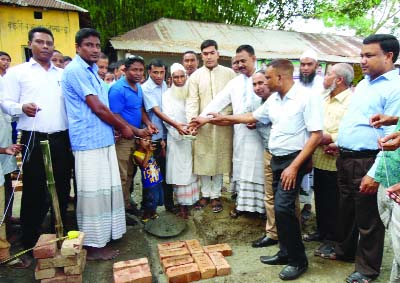
BSS, Rajshahi :
Some 5,880 drought hit-families including 5,417 ethnic minorities ones have been brought under safe drinking water source through commissioning of 95 submersible pumps in the high Barind tract.
The pumps along with 30,027 feet pipelines were commissioned with intervention of ‘Integrated Water Resource Management (IWRM)’ Project benefiting 26,463 people including 13,103 women in 135 remote villages.
The project is being implemented in drought affected 35 Union Parishads and four Pourasavas in Rajshahi and Chapainawabgonj districts since 2015 by DASCOH Foundation and Swiss Red Cross with financial support from Swiss Agency for Development and Cooperation (SDC).
The scheme intends to supply safe drinking water in those drought-prone areas where acute crisis of drinking water exists. Its main objective is to supply round-the-year potable water to all people in the targeted area, said Jahangir Alam Khan, Assistant Project Coordinator of IWRM.
Project Engineer Nur-e-Azam Siddique said there is a shortage of drinking water in the vast Barind tract during the dry season and the problem has become acute for the last couple of years making the marginalized women especially the ethnic minorities ones worst vulnerable.
In the wake of inadequate aquifer recharge, groundwater level is declining alarmingly in the high Barind tract posing a serious threat to its farming sector besides living and livelihood condition.
The areas have been identified as water-crisis. Of those, condition of Badhair UP in Tanore Upazila and Jhilim UP in Chapainawabganj Sadar upazila is worst, added Engineer Azam.
The existing shallow water technologies have become ineffective currently and demand for deep tube-well and submersible pumps has increased in the area due to rapid declining of groundwater table along with arsenic contamination in shallow aquifer in some areas.
But, cost of the deep tube well is very high and especially unaffordable for the poor community. In this situation, our public health is in a threatened condition due to lack of safe water, proper sanitation facilities and inadequate hygiene practice.
Some 5,880 drought hit-families including 5,417 ethnic minorities ones have been brought under safe drinking water source through commissioning of 95 submersible pumps in the high Barind tract.
The pumps along with 30,027 feet pipelines were commissioned with intervention of ‘Integrated Water Resource Management (IWRM)’ Project benefiting 26,463 people including 13,103 women in 135 remote villages.
The project is being implemented in drought affected 35 Union Parishads and four Pourasavas in Rajshahi and Chapainawabgonj districts since 2015 by DASCOH Foundation and Swiss Red Cross with financial support from Swiss Agency for Development and Cooperation (SDC).
The scheme intends to supply safe drinking water in those drought-prone areas where acute crisis of drinking water exists. Its main objective is to supply round-the-year potable water to all people in the targeted area, said Jahangir Alam Khan, Assistant Project Coordinator of IWRM.
Project Engineer Nur-e-Azam Siddique said there is a shortage of drinking water in the vast Barind tract during the dry season and the problem has become acute for the last couple of years making the marginalized women especially the ethnic minorities ones worst vulnerable.
In the wake of inadequate aquifer recharge, groundwater level is declining alarmingly in the high Barind tract posing a serious threat to its farming sector besides living and livelihood condition.
The areas have been identified as water-crisis. Of those, condition of Badhair UP in Tanore Upazila and Jhilim UP in Chapainawabganj Sadar upazila is worst, added Engineer Azam.
The existing shallow water technologies have become ineffective currently and demand for deep tube-well and submersible pumps has increased in the area due to rapid declining of groundwater table along with arsenic contamination in shallow aquifer in some areas.
But, cost of the deep tube well is very high and especially unaffordable for the poor community. In this situation, our public health is in a threatened condition due to lack of safe water, proper sanitation facilities and inadequate hygiene practice.

